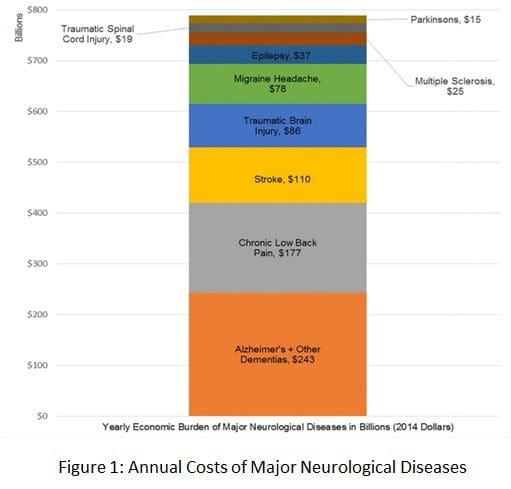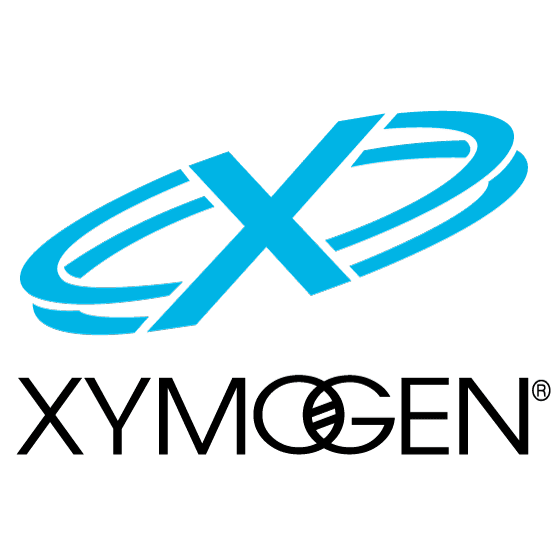Neurological diseases are characterized as health issues associated with the brain, the spine, and the nerves which connect them. Neurological disease is considered to be one of the most prevalent health issues with a high burden to the patients, their families, and society. However, there are now estimates of the burden of neurological diseases in the United States.
Table of Contents
Neurological Disease Prevalence and Costs
The most prevalent and costly neurological diseases, according to several recent research studies, include Alzheimer disease and other dementias, chronic low back pain, stroke, traumatic brain injury, migraine headaches, epilepsy, multiple sclerosis, spinal cord injury, and Parkinson’s disease. Many other neurological diseases were excluded due to their mixed etiologies.
The most common neurological disorders described above cost the United States approximately $789 billion in 2014, which may increase as the elderly population increases between 2011 and 2050, according to a research study published in the Annals of Neurology. The research study demonstrates the price of the serious annual financial burden in the US and has been demonstrated as healthcare professionals have suggested budget reductions for federally-funded research studies.
According to these demographic statistics, the American Neurological Association, or the ANA, commissioned a research study by former ANA marketing committee and public advocacy committee chair Clifton L. Gooch, MD, currently professor and chair of the Department of Neurology in the University of South Florida’s Morsani College of Medicine in Tampa.
The research study, the Burden of Neurological Disease in the United States: A Summary Report and Call to Action, demonstrated the annual cost of the most prevalent neurological diseases, including Alzheimer’s disease and other dementias, chronic low back pain, stroke, traumatic brain injury, migraine headaches, epilepsy, multiple sclerosis, spinal cord injury, and Parkinson’s disease. Neurological disease ultimately affects an estimated 100 million people in the United States every year and, together with the costs of stroke and dementia alone, these are estimated to total over $600 billion by 2030.

Funding for Neurology in the United States
The tremendous and sustained capital investments made in cardiovascular and cancer research studies beginning in the 1970s have considerably increased lifespan. Ironically, however, the number of older adults who have a higher chance of developing neurological diseases have increased, which has developed a growing outbreak among healthcare professionals.
“Preliminary research studies, including those of cancer, focus considerable research study investment to the neurological diseases which are impacting the quality of life and mortality of more and more people in the United States every year,” stated Gooch, referring to the $1.8 billion in funding for cancer and neurology research approved by Congress in 2016.
“We hope the findings of the report will serve as a wake-up call to Congress to improve much needed clinical and basic research funding necessary to discover treatments which can mitigate, and finally cure, the considerable amount of neurological diseases which have developed profound consequences in our patients as well as for the national economy.”
“The future of funding for neurological research studies was an issue in 2012 when the ANA voted to support this particular research study,” stated ANA President Barbara G. Vickrey, MD, MPH. “With the reductions now being suggested to the NIH funding from the President of the United States, this has become of even greater concern today. As representatives of the scholars working to eradicate these health issues, we feel we must raise our collective perceptions, armed with the facts.”
Annual Cost of Neurological Disease Overview
Researchers gathered the information from the research study through a complete review of the world literature among the most prevalent and costly neurological diseases in the United States. To be conservative, researchers focused on the prevalence and cost estimates they considered to be the most comprehensive and accurate, excluding neurological diseases, such as depression and chronic pain, which frequently have mixed etiologies beyond primary nervous system injury.
“A complete accounting of all neurological diseases would considerably increase price tag estimates,” wrote the authors of the research study. Indirect and direct costs for the most common neurological diseases previously mentioned above, have been demonstrated in the research study and were estimated according to maintenance standards for each health issue.
Alzheimer’s disease and other dementias accounted for $243 billion of their $789 billion total, while chronic lower back pain represented $177 billion, and stroke represented $110 billion. As well as documenting the fiscal costs of neurological disease, Gooch and his USF colleagues ultimately recommend an action plan for reducing the burden of these health issues through infrastructure investment in neurological research and enhanced clinical management of neurological disorders.

Many research studies have demonstrated how several of the most common neurological diseases pose a serious annual financial burden in the United States. The most prevalent and costly neurological health issues, such as Alzheimer’s disease and other dementias, chronic low back pain or sciatica, as well as stroke, among other common neurological diseases mentioned above, have been estimated to have an annual cost totalling $789 billion in 2014, according to research studies. These annual costs have also been demonstrated to considerable increase further over time. – Dr. Alex Jimenez D.C., C.C.S.T. Insight
Diet and Exercise for Neurological Disease
The purpose of the article is to demonstrate the annual cost of several of the most prevalent neurological diseases. Neurological diseases are associated with the brain, the spine, and the nerves. The scope of our information is limited to chiropractic, musculoskeletal and nervous health issues as well as functional medicine articles, topics, and discussions. To further discuss the subject matter above, please feel free to ask Dr. Alex Jimenez or contact us at 915-850-0900 .
Curated by Dr. Alex Jimenez
Additional Topic Discussion: Chronic Pain
Sudden pain is a natural response of the nervous system which helps to demonstrate possible injury. By way of instance, pain signals travel from an injured region through the nerves and spinal cord to the brain. Pain is generally less severe as the injury heals, however, chronic pain is different than the average type of pain. With chronic pain, the human body will continue sending pain signals to the brain, regardless if the injury has healed. Chronic pain can last for several weeks to even several years. Chronic pain can tremendously affect a patient’s mobility and it can reduce flexibility, strength, and endurance.
Formulas for Methylation Support
XYMOGEN’s Exclusive Professional Formulas are available through select licensed health care professionals. The internet sale and discounting of XYMOGEN formulas are strictly prohibited.
Proudly, Dr. Alexander Jimenez makes XYMOGEN formulas available only to patients under our care.
Please call our office in order for us to assign a doctor consultation for immediate access.
If you are a patient of Injury Medical & Chiropractic Clinic, you may inquire about XYMOGEN by calling 915-850-0900.
For your convenience and review of the XYMOGEN products please review the following link.*XYMOGEN-Catalog-Download
* All of the above XYMOGEN policies remain strictly in force.
Post Disclaimer
Professional Scope of Practice *
The information on this blog site is not intended to replace a one-on-one relationship with a qualified healthcare professional or licensed physician and is not medical advice. We encourage you to make healthcare decisions based on your research and partnership with a qualified healthcare professional.
Blog Information & Scope Discussions
Welcome to El Paso's Premier Wellness and Injury Care Clinic & Wellness Blog, where Dr. Alex Jimenez, DC, FNP-C, a board-certified Family Practice Nurse Practitioner (FNP-BC) and Chiropractor (DC), presents insights on how our team is dedicated to holistic healing and personalized care. Our practice aligns with evidence-based treatment protocols inspired by integrative medicine principles, similar to those found on this site and our family practice-based chiromed.com site, focusing on restoring health naturally for patients of all ages.
Our areas of chiropractic practice include Wellness & Nutrition, Chronic Pain, Personal Injury, Auto Accident Care, Work Injuries, Back Injury, Low Back Pain, Neck Pain, Migraine Headaches, Sports Injuries, Severe Sciatica, Scoliosis, Complex Herniated Discs, Fibromyalgia, Chronic Pain, Complex Injuries, Stress Management, Functional Medicine Treatments, and in-scope care protocols.
Our information scope is limited to chiropractic, musculoskeletal, physical medicine, wellness, contributing etiological viscerosomatic disturbances within clinical presentations, associated somato-visceral reflex clinical dynamics, subluxation complexes, sensitive health issues, and functional medicine articles, topics, and discussions.
We provide and present clinical collaboration with specialists from various disciplines. Each specialist is governed by their professional scope of practice and their jurisdiction of licensure. We use functional health & wellness protocols to treat and support care for the injuries or disorders of the musculoskeletal system.
Our videos, posts, topics, subjects, and insights cover clinical matters and issues that relate to and directly or indirectly support our clinical scope of practice.*
Our office has made a reasonable effort to provide supportive citations and has identified relevant research studies that support our posts. We provide copies of supporting research studies available to regulatory boards and the public upon request.
We understand that we cover matters that require an additional explanation of how they may assist in a particular care plan or treatment protocol; therefore, to discuss the subject matter above further, please feel free to ask Dr. Alex Jimenez, DC, APRN, FNP-BC, or contact us at 915-850-0900.
We are here to help you and your family.
Blessings
Dr. Alex Jimenez DC, MSACP, APRN, FNP-BC*, CCST, IFMCP, CFMP, ATN
email: coach@elpasofunctionalmedicine.com
Licensed as a Doctor of Chiropractic (DC) in Texas & New Mexico*
Texas DC License # TX5807
New Mexico DC License # NM-DC2182
Licensed as a Registered Nurse (RN*) in Texas & Multistate
Texas RN License # 1191402
ANCC FNP-BC: Board Certified Nurse Practitioner*
Compact Status: Multi-State License: Authorized to Practice in 40 States*
Graduate with Honors: ICHS: MSN-FNP (Family Nurse Practitioner Program)
Degree Granted. Master's in Family Practice MSN Diploma (Cum Laude)
Dr. Alex Jimenez, DC, APRN, FNP-BC*, CFMP, IFMCP, ATN, CCST
My Digital Business Card




